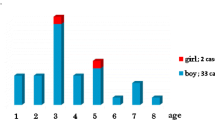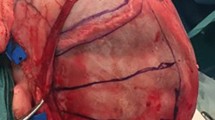Abstract
From 1973 to 1986, 50 infants with sagittal synostosis have been operated by three different methods of craniectomy (linear craniectomy and extended craniectomies, as proposed by Schut and Epstein et al.). Preoperatively, the mean cephalic index was 67±4, 35.5% had clinical findings as cerebral palsy, psychomotor retardation and/or neurological signs, and intraoperatively the epidural pressure was more than 200 mm H2O in 60% (recorded in the last 20 patients). The mean follow-up time was 4.7 (1–10.6) years. Postoperatively, only 14.5% had minor clinical signs, which were mostly not in relation to the former scaphocephaly. Half of the patients with increased ICP had clinical signs preoperatively, and none of the 20 patients had distinct findings postoperatively. Out of the 20 children operated on by linear craniectomy or by Schut's method up to 1980, two-thirds had no school problems and one-third some school problems; one-third had occasionally headaches and one-quarter ametropia. Concerning the aesthetic results, Epstein's method and, somewhat less Schut's method, were superior to linear craniectomy, as verified by craniometry and by the tracings of the outlines of the neurocranium 0.4–0.7 and 1.6–2.0 years postoperatively: mean cephalic indices 73±5 (normal in one-fourth), 74±7 (normal in half) and 79±4 (normal in nearly all patients). Epstein's method is superior to the other two methods because it renders it possible to increase the breadth the greatest during the period of greatest postnatal brain growth. In addition to the effect on the neurocranium, the extended craniectomies add to normalization of the base of the skull (in contrast to the natural history of scaphocephaly). In the long run, the results obtained remain the same. The disadvantage of residual skull defects (approximately 11% of the patients with extended craniectomies) can be avoided by performing surgery prior to 4–6 months of age or by preserving the removed bone in a deep-freeze for a limited time.
Similar content being viewed by others
References
Berner Datenbuch der Pädiatrie (1985) Gustav Fischer, Stuttgart New York
Epstein N, Epstein F, Newman G (1982) Total vertex craniectomy for the treatment of scaphocephaly. Child's Brain 9:309–316
Haas LL (1952) Roentgenological skull measurements and their diagnostic applications. Am J Roentgenol 67:197–209
Hemple DJ, Harris LE, Svien HJ, Holman CB (1961) Craniosynostosis involving the sagittal suture only: guilt by association? J Pediatr 58:342–355
Ivan LP, Choo SH (1982) Clinical and experimental observations with the fiberoptic epidural sensor and the Ladd pressure monitor. Monogr Paediatr 15:8–11
Kaiser G (1982) Preliminary experiences with the lateral canthal advancement of the supraorbital margin. Z Kinderchir 35:83–85
Laitinen L (1956) Craniosynostosis. Premature fusion of the cranial sutures. An experimental, clinical and histological investigation with particular reference to the pathogenesis and etiology of the disease. Ann Fennicae Paediatr [Suppl 6] 2:1–130
Lusted LB, Keats TE (1978) Atlas of roentgenographic measurement, 4th edn. Yearbook Medical Publishers, Chicago
Milhorat TH (1978) Pediatric neurosurgery. Contemporary neurology series 16. Davis, Philadelphia
Moss ML (1959) The pathogenesis of premature cranial synostosis in man. Acta Anat 37:351–370
Moss ML, Greenberg SN (1955) Postnatal growth of the human skull base. Angle Orthodont 25:77–84
Numoto M, Wallman JK, Donaghy RMP (1973) Pressure indication bag for monitoring intracranial pressure. J Neurosurg 39:784–787
Paraicz E (1982) ICP in infancy and childhood. Introduction. Monogr Paediatr 15:1–7
Poppel MH, Jacobson HG, Duff BK, Gottlieb C (1953) Basilar impression and platybasia in Paget's disease. Radiology 61:639–644
Renier D, Sainte-Rose C, Marchac D, Hirsch JF (1982) Intracranial pressure in craniostenosis. J Neurosurg 57:370–377
Sörensen N (1986) Effects on head form of intrauterine compression of passage through the birth canal. In: Raimondi AJ, Choux M, Di Rocco C (eds) Head injuries in the newborn and infant. Springer, New York Berlin Heidelberg
Author information
Authors and Affiliations
Rights and permissions
About this article
Cite this article
Kaiser, G. Sagittal synostosis — its clinical significance and the results of three different methods of craniectomy. Child's Nerv Syst 4, 223–230 (1988). https://doi.org/10.1007/BF00270918
Received:
Issue Date:
DOI: https://doi.org/10.1007/BF00270918




